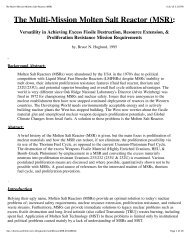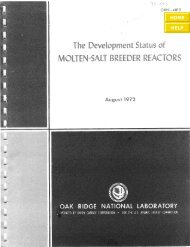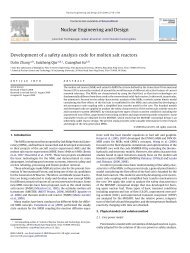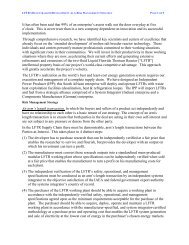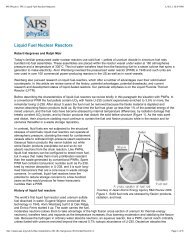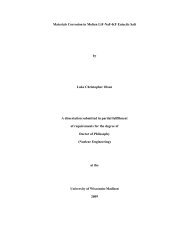What is an Open Cycle Gas Turbine
What is an Open Cycle Gas Turbine
What is an Open Cycle Gas Turbine
Create successful ePaper yourself
Turn your PDF publications into a flip-book with our unique Google optimized e-Paper software.
PROPRIETARY <strong>an</strong>d CONFIDENTIAL<strong>What</strong> <strong>is</strong> <strong>an</strong> <strong>Open</strong> <strong>Cycle</strong> <strong>Gas</strong> <strong>Turbine</strong> (OCGT)?An open cycle gas turbine <strong>is</strong> a combustion turbine pl<strong>an</strong>t fired by liquid fuel to turn a generatorrotor that produces electricity. The residual heat <strong>is</strong> exhausted to atmosphere at about 550 degreesCelsius. The turbine <strong>an</strong>d generators are housed in enclosures designed to reduce no<strong>is</strong>e levels <strong>an</strong>doccupy <strong>an</strong> area of approximately 75m X 25m per unit. The exhaust stack height <strong>is</strong>approximately 30m with the height of the intake structure being 20m. NOTE 1A compressor sucks air in from the atmosphere <strong>an</strong>d compresses it through a number ofcompressor stages. Fuel <strong>is</strong> pumped into a combustion chamber <strong>an</strong>d mixed with the compressedair. The fuel/air mixture <strong>is</strong> then ignited to form hot, high velocity gas. Th<strong>is</strong> gas <strong>is</strong> passedthrough turbine blades that turn the shaft that <strong>is</strong> attached to the rotor of the generator. The rotorturns inside the stator <strong>an</strong>d electricity <strong>is</strong> generated. Th<strong>is</strong> electricity <strong>is</strong> then d<strong>is</strong>tributed via the highvoltage network to where it <strong>is</strong> needed. NOTE 2<strong>Open</strong> cycle gas turbine pl<strong>an</strong>ts, without a steam cycle, are sometimes installed as peakingcapacity; their thermal efficiency <strong>is</strong> much lower. The high running cost per hour <strong>is</strong> offset bythe low capital cost <strong>an</strong>d the intention to run such units only a few hundred hours per year.Page 1 of 6
PROPRIETARY <strong>an</strong>d CONFIDENTIALByproducts of these power thermal pl<strong>an</strong>ts’ operation need to be considered in both the design<strong>an</strong>d operation. Waste heat due to the finite efficiency of the power cycle must be released to theatmosphere, using a cooling tower, or river or lake water as a cooling medium. NOTE 3. Theflue gas from combustion of the fossil fuels <strong>is</strong> d<strong>is</strong>charged to the air; th<strong>is</strong> contains carbon dioxide<strong>an</strong>d water vapour, as well as other subst<strong>an</strong>ces such as nitrogen, nitrogen oxides, sulfur oxides.Fossil fueled power stations are major emitters of CO 2 , the most import<strong>an</strong>t greenhouse gas(GHG) which according to the consensus of scientific org<strong>an</strong><strong>is</strong>ations <strong>is</strong> a major contributor to theglobal warming observed over the last 100 years. Carbon capture <strong>an</strong>d storage of em<strong>is</strong>sions arenot expected to be available on a commercial economically viable bas<strong>is</strong> until 2025. NOTE 4.An Eskom OCGT ProjectDue to the growth in the South Afric<strong>an</strong> economy, which results in <strong>an</strong> increased dem<strong>an</strong>d forelectricity, Eskom’s excess electricity generation capacity <strong>is</strong> being depleted, especially when itcomes to supplying electricity during peak dem<strong>an</strong>d periods. When government gave Eskom thegreen light to build new power stations in October 2004, work started in earnest to determine thekind of peaking pl<strong>an</strong>t that c<strong>an</strong> be built in a relatively short time, given that it became clear thatEskom would need additional capacity to meet the dem<strong>an</strong>d during the winter of 2007.Based on the following considerations, it was decided to build two OCGT pl<strong>an</strong>ts:• The technology has been proven all over the world <strong>an</strong>d has a good track record.• There are numerous suppliers across the world.• OCGTs c<strong>an</strong> be built in 3 to 4 years, <strong>an</strong>d if fast tracked, within even shorter project lead times.The proposed OCGT gas turbine stations will add approximately 1000MW of new generationcapacity. It <strong>is</strong> estimated that <strong>an</strong> open cycle gas turbine’s life sp<strong>an</strong> <strong>is</strong> 25 years. NOTE 5.Background of OCGTs in the Western Cape.From: BUSINESS DAY, 31 Mar 2010 - Joh<strong>an</strong>nesburg: According to industrial <strong>an</strong>dpetrochemical consult<strong>an</strong>t Philip Lloyd, peak dem<strong>an</strong>d in the Western Cape region <strong>is</strong> 5300MW.Koeberg provides 1800MW of the peak dem<strong>an</strong>d. <strong>Gas</strong> comp<strong>an</strong>y Gigajoule w<strong>an</strong>ts Eskom toconvert the Ankerlig power station to a combined-cycle gas turbine. Eskom says it’s infeasible.A reliable supply of natural gas <strong>is</strong> not available now in required qu<strong>an</strong>tities.Another 3000MW could be supplied by wind farms, says Andrew Marquard of the EnergyResearch Centre at the Univ. of Cape Town. Th<strong>is</strong> <strong>is</strong> equivalent to only 1000MW of coal power,because wind power, unlike coal, <strong>is</strong> available only about 1/3 of the time, while coal providesconst<strong>an</strong>t base-load power. Thus wind would require st<strong>an</strong>dby peaking power when there <strong>is</strong>dem<strong>an</strong>d but no wind. In the case of wind, 2/3 rds of the time its contribution would have to besupplied by peaker pl<strong>an</strong>ts such as the open cycle gas turbines. NOTE 6.To illustrate, the Ankerlig power station, <strong>an</strong> open-cycle gas-turbine pl<strong>an</strong>t, has nine units of150MW each, giving a total of 1350MW. It <strong>is</strong> a peaking power pl<strong>an</strong>t, me<strong>an</strong>ing it <strong>is</strong> operationalfor only 6% of the year, <strong>an</strong>d uses diesel to produce power. But open-cycle gas-turbine pl<strong>an</strong>ts areinefficient, <strong>an</strong>d diesel <strong>is</strong> <strong>an</strong> expensive way to produce power. NOTE 7. Lloyd says Eskom'saverage cost price of electricity <strong>is</strong> 40c/kWh, compared to R3/kWh for the open-cycle gasturbinepl<strong>an</strong>ts run on diesel. The utility uses <strong>an</strong> average of 40-million litres of diesel a yearin these power stations. NOTE 8.Page 2 of 6
PROPRIETARY <strong>an</strong>d CONFIDENTIALNOTE 1.By contrast, each LFTR <strong>an</strong>d its gas turbine generator will be co-located 10 meters undergroundon a one acre (4,047 m 2 , or .655 hectares) footprint with its municipal power grid customer(s).LFTR waste heat <strong>is</strong> exploited on coastal installations with hybrid desalination pl<strong>an</strong>ts, <strong>an</strong>d oninl<strong>an</strong>d installations with airconditioning <strong>an</strong>d / or heat loops. There are no water cooling orcooling towers associated with LFTRs. In addition, there are no large fuel dumps as <strong>is</strong> the casewith diesel fuel depots held in reserve to power open cycle gas turbines. LFTRs are fueled withthorium, a relatively heavy, not-f<strong>is</strong>sile heavy metal, in its natural form, thorium oxide THO 2NOTE 2.As LFTRs are co-located with their customers, there <strong>is</strong> no need for R 15 million per mile longd<strong>is</strong>t<strong>an</strong>ce high-voltage tr<strong>an</strong>sm<strong>is</strong>sion facilities with their six-traffic-l<strong>an</strong>e-wide right of wayextending from the power pl<strong>an</strong>t to the faraway customers. As OCGTs are to be used as peakingpl<strong>an</strong>ts, their sparse electricity output (provided 6% of the time) must amortize the cost of theelectricity loss (7%) <strong>an</strong>d the construction cost of the long-haul tr<strong>an</strong>sm<strong>is</strong>sion facilities.NOTE 3.Whether used as a base load electricity generator, or a peaking power generator, the LFTR’soperating costs stay cons<strong>is</strong>tent because of its design.NOTE 4.The average 1000 MW OCGT will require multiple 30 meter cooling towers, where water <strong>is</strong> notused. The average coal or nuclear pl<strong>an</strong>t generating 1000MW will require 600,000 gallons ofriver water to cool the power pl<strong>an</strong>t or it will evaporate 20,000 gallons per minute to cool thepower pl<strong>an</strong>t.The single most volatile aspect of current nuclear reactors <strong>is</strong> pressurized water. In the 441LWRs operating worldwide today water serves as both the reactor’s cool<strong>an</strong>t <strong>an</strong>d neutronmoderator, (with graphite control rods added by regulators for safety “defense in depth”).F<strong>is</strong>sion heat causes water to boil, either directly in the core or in a steam generator that drives aturbine. In the core, water <strong>is</strong> maintained at a high pressure to ra<strong>is</strong>e its boiling temperature. Theexplosive pressures involved (up to 160 atmospheres) are contained by a highly engineeredsystem of expensive piping <strong>an</strong>d containment vessels collectively named the ‘pressure boundary’– the ultimate line of defense. Th<strong>is</strong> ‘pressure boundary’ <strong>is</strong> a massive, costly containmentbuilding surrounding the reactor, designed to withst<strong>an</strong>d <strong>an</strong>y explosive calamity <strong>an</strong>d prevent theout-of-control release of radioactive materials.The LFTR operates at the same pressure as the earth’s atmosphere. The neutral pressure dropsthe cost <strong>an</strong>d size of the LFTR’s structure – there are no billion-dollar containment vesselrequirements. There <strong>is</strong> no pressure explosion possible. A leak in a LFTR tr<strong>an</strong>sport line will dropthe molten salt into the catch basin where it stops reacting, cools off <strong>an</strong>d freezes into a solid (at450º C). If the LFTR’s heat exp<strong>an</strong>ds its liquid fuel beyond intended levels, the LFTR core’sreactivity falls inst<strong>an</strong>tly. Also, if the molten salt gets hotter th<strong>an</strong> <strong>is</strong> intended, the frozen salt plugPage 3 of 6
PROPRIETARY <strong>an</strong>d CONFIDENTIALA critically import<strong>an</strong>t factor affecting the true value of the capacity of <strong>an</strong>y generating unit <strong>is</strong> howmuch of the unit’s “rated” or “nameplate” capacity c<strong>an</strong> definitely be counted on to be available togenerate electricity <strong>an</strong>d how much it c<strong>an</strong> definitely be counted to produce at the time of peakelectricity dem<strong>an</strong>d in the control area. Th<strong>is</strong> measure <strong>is</strong> referred to in the electric industry as the unit’s“capacity value.”In fact, regardless of their “rated” or “nameplate” capacity, wind turbines c<strong>an</strong>’t be counted on toproduce <strong>an</strong>y electricity at the time it <strong>is</strong> most needed; i.e., when electricity dem<strong>an</strong>d reaches peaklevels. Therefore, wind turbines really have little or no real “capacity value,” as that term <strong>is</strong> used inthe electric industry.Because wind turbines have little or no real “capacity value,” electric grid m<strong>an</strong>agers responsible forassuring the reliability of electric service must, instead, look to other generating units – i.e., those thatare reliable <strong>an</strong>d d<strong>is</strong>patchable for the capacity that <strong>is</strong> needed at the time of peak electricity dem<strong>an</strong>d. Inmost areas of the US, peak electricity dem<strong>an</strong>d <strong>is</strong> likely to occur in late afternoon on hot, weekdays inJuly or August.When attempting to compare either the cost or value of electricity from wind turbines, it <strong>is</strong> import<strong>an</strong>tto recognize that the fact that wind turbines produce little or no electricity most of the time me<strong>an</strong>sthat their “rated” or “nameplate” capacity <strong>is</strong> not comparable in value to the “rated” or “nameplate”capacity of a reliable generating unit. (A clear example of the “crabapple to or<strong>an</strong>ge” <strong>an</strong>alogy.)The true value of a kilowatt-hour (kWh) of electricity depends on when it <strong>is</strong> produced. Specifically, akWh of electricity produced during periods of high or peak electricity dem<strong>an</strong>d has much higher valueth<strong>an</strong> a kWh produced when dem<strong>an</strong>d <strong>is</strong> low (e.g., during nighttime hours in most areas of the US).NOTE 7.The delicate bal<strong>an</strong>ce of generation <strong>an</strong>d load on <strong>an</strong> electricity grid continuously fluctuates, oftensignific<strong>an</strong>tly, <strong>an</strong>d on varying timescales as industrial <strong>an</strong>d household dem<strong>an</strong>ds ebb <strong>an</strong>d flowthroughout a day, a week, or a season. Generation must adapt where <strong>an</strong>d when required. Everypower grid requires load following, peaking power, <strong>an</strong>d base load power. Nuclear <strong>an</strong>d coalpl<strong>an</strong>ts are typically relied on to meet a grid’s continuous energy dem<strong>an</strong>d, producing electricity ata const<strong>an</strong>t rate. The grid adds additional generation to available base load to meet moment-tomomentdem<strong>an</strong>d in the grid – load following with peaker pl<strong>an</strong>ts.LWRs’ responsiveness to load <strong>is</strong> d<strong>is</strong>rupted by the build up of neutron po<strong>is</strong>ons, like 135 Xenon, apowerful neutron absorber that captures neutrons needed for heat generation <strong>an</strong>d breeding newfuel. Adding or subtracting nuclear reactivity required by m<strong>an</strong>y load following scenariosaccelerates LWR Xenon production, as does varying its reactor power.By contrast, load following <strong>is</strong> straightforward for LFTRs. The heat energy <strong>is</strong> simply drawn outof the heat exch<strong>an</strong>ger. The returning fluid fuel <strong>is</strong> thus colder <strong>an</strong>d slightly denser, so power goesup automatically to match its absence of heat – due to the strong negative temperature coefficientof the LFTR’s fluid fuel. If the LFTR’s heat exch<strong>an</strong>gers don’t draw out enough heat thereturning fluid fuel <strong>is</strong> hotter <strong>an</strong>d the LFTR reactivity goes down. If the fuel r<strong>is</strong>es past a thresholdtemperature, the LFTR simply shuts off reactivity altogether. Load following by the LFTR <strong>is</strong> <strong>an</strong>automatic, ‘h<strong>an</strong>ds-off’ processPage 5 of 6
PROPRIETARY <strong>an</strong>d CONFIDENTIALNOTE 8.In 2013 / 14 when these OCGTs come on line, the RSA Eskom m<strong>an</strong>dated price (because ofinterest service on new coal pl<strong>an</strong>ts) will be more th<strong>an</strong> R 1.20 per kWh. Also, the R 3 per kWhfor diesel-running OCGTs will go up because of the price of oil which <strong>is</strong> already 20% higher inFebruary ’11 th<strong>an</strong> it was in March 2010 when Mr. Lloyd made h<strong>is</strong> statement.By contrast, the LFTR will be able to make a profit selling its electricity at $ 0.65 per kWh in2015 when it becomes available for power generation.Page 6 of 6



